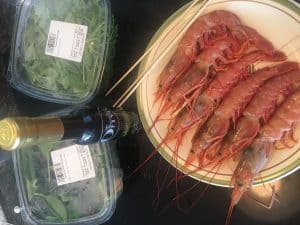- in guest/interview , health by allan
Real Food Fake Food | Larry Olmsted

Royal Red Shrimp Lunch
Today we meet Larry Olmsted, an award-winning food author and columnist. In his book, Real Food Fake Food, Why You Don't Know What You're Eating & What You Can Do About It, Larry discusses how various foods we are served in restaurants or buy at grocery stores may actually be something entirely different.
There's nothing more fundamental than knowing what you're putting in your mouth. ~ Kelsey Timberman
Fake Food
When you don't get what you think you're buying. This is not a judgement on the quality you're getting. This comes in three forms:
- Something completely different – As in where you order flounder but the actual fish served is tilapia (an entirely different species of fish).
- Inferior version – A worse quality or it is diluted. This is common with extra virgin olive oil.
- Geographic indications – Despite offering you Kobe beef the restaurant may be serving you beef that is not from Kobe, Japan.
Fish
Nearly 1/3 of the time, a different fish is substituted with another fish. Sometimes this is where you're served farmed fish that was marketed as wild-caught. Or it may be an entirely lower standard species of fish. The more expensive the fish, the more likely it is to be subject to fish fraud. Nearly all of the red snapper served in restaurants is not red snapper.
As a tip for getting what you're paying for, go to the fish markets on the water. There you can often see the whole fish, which makes it much harder for you to be duped.
Olive Oil
Good extra virgin olive oil is very good for your health. This is the top most rating for olive oil and is quite rare. Studies have demonstrated that the majority of olive oil sold in grocery stores do not meet the standard for extra virgin. You can order olive oil from online club like Fresh Pressed Olive Oil Club. It can be quite expensive. I personally buy olive oil at a specialty retail store, where I'm able to taste it before I buy.
Olive Oil is a fruit oil and as a result, it goes bad quickly. You should check the harvest date or pressed date. Good quality olive oil should be used within a year of harvest. Upon opening a bottle, you should use it within a month. Knowing the source, so you can make sure you're buying real olive oil.
Links

